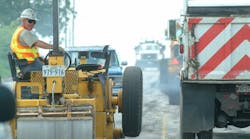A Congressman who will play a major role in the passage of this year’s highway appropriations bill grabbed a lot of headlines when he declared two weeks back that increasing the federal fuel tax should not even be on the table, this time around at least.
However, if Rep. Bill Shuster (R-PA ), the influential Chairman of the House Transportation & Infrastructure Committee, sticks to that position, he may find himself much like the tyke with his finger in the dyke attempting to hold back a flood, given the groundswell of support mounting for the first fuel-tax hike in 20 years.
But, wait. There’s more. One transportation-policy expert contends that a “revolution” in transportation funding launched by more than a third of the separate states is already under way.
Getting back to the fuel tax, trucking’s biggest lobby, the American Trucking Assns. (ATA), has already made known its strong support of H.R. 3636, a bill that would hike the federal fuel tax by 15 cents and index the tax to inflation to ensure it would remain a “sustainable” source of revenue. That measure was introduced in December by Rep. Earl Blumenauer (D-OR).
“ATA is very pleased to support Congressman Blumenauer's proposal to increase and index the federal fuel tax," said the group’s president & CEO Bill Graves. “The additional investment in highway projects made possible by this new revenue will significantly improve the safety, reliability and efficiency of the trucking industry, to the benefit of all Americans.
Adding fuel to that fire, today the Center for American Progress, a nonpartisan progressive lobby, published a report tellingly titled “Understanding the Highway Trust Fund and the Perils of Inaction” that forcefully argues the dire need to increase the federal fuel tax as part of this year’s transportation-funding bill.
“Dramatic improvements in vehicle fuel efficiency and reduced driving have substantially decreased the amount of gas tax revenue deposited in the HTF each year,” pointed out the report’s author, Kevin DeGood, director of infrastructure policy for the Center.
“The Simpson-Bowles deficit commission called for increasing the gas tax by 15 cents to stabilize the Highway Trust Fund [HTF] and allow for programmatic growth. Congress must take action soon to avoid bankrupting the fund and hurting our economy,” he stated.
DeGood noted that Congress last hiked the gasoline tax in 1993, raising it from 14.1 cents to 18.4 cents per gallon, and raised the diesel tax by an equivalent amount.
But he argued that since then, “significant improvements” in vehicle efficiency as well as inflation have combined to cut tax revenues and the purchasing power of the remaining dollars:
While not mentioning the next-stage MPGrules for commercial vehicles, DeGood did point out that “Corporate average fuel-economy standards will rise to 54.5 MPG for cars and light-duty trucks by model year 2025, which will approximately double the efficiency of vehicles compared to current levels and dramatically reduce the amount of tax revenue flowing to the HTF, crippling federal surface transportation programs.”
Despite all such arguments for hiking federal fuel taxes, could it be that state governments will act enough on their own accord to fund big transportation projects to make taking that action unnecessary?
Public-policy consultant C. Kenneth Orski, publisher of Innovation Briefs, presented food for thought in that regard in remarks he prepared for a Conservative Policy Summit held earlier this month by Heritage Action, a lobbying group affiliated with the Heritage Foundation.
“It may come as a surprise to you, but there is a quiet revolution in transportation funding happening these days,” Orski stated. “Faced with a depleted Highway Trust Fund and uncertain prospects for more money from a deficit-conscious Congress, many states are taking matters into their own hands and aggressively pursuing more fiscal independence.”
Orski said that a survey his operation recently conducted points to “significant funding initiatives” in 18 states, including these:
He noted that “further evidence of local initiatives came on election day last November when voters approved over 70% of ballot measures to increase or extend funding for local transportation.”
Orski was quick to clarify that “what we are seeing today is not ‘devolution’ properly speaking”… but “a significant step in the direction of shifting more transportation decision-making to the state and local level.”
According to Orski, states are embracing long-term financing as well as access to private capital via public-private partnerships (P3s) to fund costly multi-year infrastructure projects so that they need not rely on “uncertain annual appropriations or to compete for scarce Trust Fund dollars. Instead, they are being financed with a variety of tools, such as private activity bonds, TIFIA loans, toll revenue concessions, availability payments and private risk capital.
“Our survey has identified 20 jurisdictions that are undertaking major reconstruction projects with the help of long term debt,” he advised. “In addition, states have entered into more than 30y public-private partnerships worth about $20 billion. This is on top of some $35 billion worth of municipal bonds that are annually sold to finance local transportation.”
Yet Orski remarked all that may mark only be the beginning. “As states acquire more sophistication and familiarity with credit transactions, and as federal budgetary restraints continue, long term financing of large-scale capital-intensive projects through P3s and availability payments is bound to become the states’ primary method of expanding and modernizing aging infrastructure.”
Orski contended that there are “several potential consequences” stemming from these bellwether trends:
Meanwhile, the clock ticks. Map-21, the current highway-authorization bill, expires in 223 days.
